Java NIO
一、简介
Java NIO(New IO)是从Java 1.4版本开始引入的一个新的IO API,可以替代标准的Java IO API。NIO与原来的IO有同样的作用和目的,但是使用的方式完全不同,NIO支持面向缓冲区的、基于通道的IO操作。NIO将以更加高效的方式进行文件的读写操作。
二、IO与NIO的区别
| IO | NIO |
|---|---|
| 面向流(Stream Oriented) | 面向缓冲区(Buffer Oriented) |
| 阻塞IO(Blocking IO) | 非阻塞IO(NonBlocking IO) |
| 选择器(Selectors) |
1、面向流和缓冲区
IO
传统IO在传输数据时,根据输入输出的不同需要分别建立不同的链接,而且传输的数据是以流的形式在链接上进行传输的
就像自来水要通过水管将自来水厂和家连接起来一样
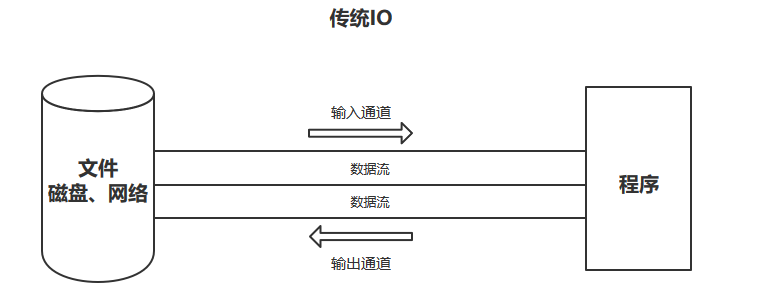
NIO
NIO在传输数据时,会在输入输出端之间建立通道,然后将数据放入到缓冲区中。缓冲区通过通道来传输数据
这里通道就像是铁路,能够连通两个地点。缓冲区就像是火车,能够真正地进行数据的传输
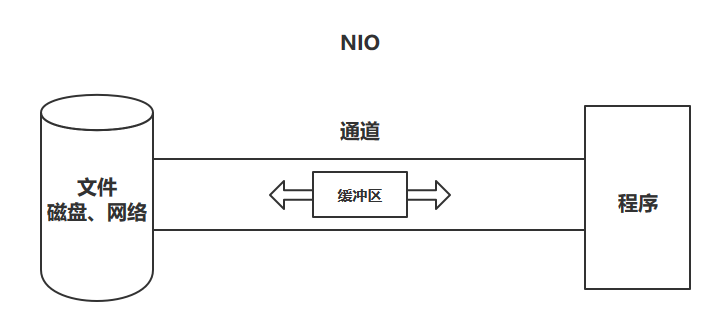
三、通道与缓冲区
Java NIO系统的核心在于:通道(Channel)和缓冲区(Buffer)。通道表示打开到 IO 设备(例如:文件、套接字)的连接。若需要使用 NIO 系统,需要获取用于连接 IO 设备的通道以及用于容纳数据的缓冲区。然后操作缓冲区,对数据进行处理
简而言之,通道负责传输,缓冲区负责存储
四、缓冲区(Buffer)
1、缓冲区类型
Buffer 就像一个数组,可以保存多个相同类型的数据。根据数据类型不同(boolean 除外) ,有以下Buffer 常用子类
- ByteBuffer
- CharBuffer
- ShortBuffer
- IntBuffer
- LongBuffer
- FloatBuffer
- DoubleBuffer
各种类型的缓冲区中,都有一个对应类型的数组,如
ByteBuffer
final byte[] hb; // Non-null only for heap buffersIntBuffer
final int[] hb; // Non-null only for heap buffers他们的继承关系如下

2、获取缓冲区
通过allocate方法可以获取一个对应缓冲区的对象,它是缓冲区类的一个静态方法
例
// 获取一个容量大小为1024字节的字节缓冲区
ByteBuffer byteBuffer = ByteBuffer.allocate(1024);3、核心属性
缓冲区的父类Buffer中有几个核心属性,如下
// Invariants: mark <= position <= limit <= capacity
private int mark = -1;
private int position = 0;
private int limit;
private int capacity;- capacity:缓冲区的容量。通过构造函数赋予,一旦设置,无法更改
- limit:缓冲区的界限。位于limit 后的数据不可读写。缓冲区的限制不能为负,并且不能大于其容量
- position:下一个读写位置的索引(类似PC)。缓冲区的位置不能为负,并且不能大于limit
- mark:记录当前position的值。position被改变后,可以通过调用reset() 方法恢复到mark的位置。
以上四个属性必须满足以下要求
mark <= position <= limit <= capacity
4、核心方法
put()方法
put()方法可以将一个数据放入到缓冲区中。
进行该操作后,postition的值会+1,指向下一个可以放入的位置。capacity = limit ,为缓冲区容量的值。

flip()方法
- flip()方法会切换对缓冲区的操作模式,由写->读 / 读->写
- 进行该操作后
- 如果是写模式->读模式,position = 0 , limit 指向最后一个元素的下一个位置,capacity不变
- 如果是读->写,则恢复为put()方法中的值

get()方法
- get()方法会读取缓冲区中的一个值
- 进行该操作后,position会+1,如果超过了limit则会抛出异常

rewind()方法
该方法只能在读模式下使用
rewind()方法后,会恢复position、limit和capacity的值,变为进行get()前的值

clean()方法
- clean()方法会将缓冲区中的各个属性恢复为最初的状态,position = 0, capacity = limit
- 此时缓冲区的数据依然存在,处于“被遗忘”状态,下次进行写操作时会覆盖这些数据

mark()和reset()方法
mark()方法会将postion的值保存到mark属性中
reset()方法会将position的值改为mark中保存的值
使用展示
public class Demo1 {
public static void main(String[] args) {
ByteBuffer byteBuffer = ByteBuffer.allocate(1024);
System.out.println("放入前参数");
System.out.println("position " + byteBuffer.position());
System.out.println("limit " + byteBuffer.limit());
System.out.println("capacity " + byteBuffer.capacity());
System.out.println();
System.out.println("------put()------");
System.out.println("放入3个数据");
byte bt = 1;
byteBuffer.put(bt);
byteBuffer.put(bt);
byteBuffer.put(bt);
System.out.println("放入后参数");
System.out.println("position " + byteBuffer.position());
System.out.println("limit " + byteBuffer.limit());
System.out.println("capacity " + byteBuffer.capacity());
System.out.println();
System.out.println("------flip()-get()------");
System.out.println("读取一个数据");
// 切换模式
byteBuffer.flip();
byteBuffer.get();
System.out.println("读取后参数");
System.out.println("position " + byteBuffer.position());
System.out.println("limit " + byteBuffer.limit());
System.out.println("capacity " + byteBuffer.capacity());
System.out.println();
System.out.println("------rewind()------");
byteBuffer.rewind();
System.out.println("恢复后参数");
System.out.println("position " + byteBuffer.position());
System.out.println("limit " + byteBuffer.limit());
System.out.println("capacity " + byteBuffer.capacity());
System.out.println();
System.out.println("------clear()------");
// 清空缓冲区,这里只是恢复了各个属性的值,但是缓冲区里的数据依然存在
// 但是下次写入的时候会覆盖缓冲区中之前的数据
byteBuffer.clear();
System.out.println("清空后参数");
System.out.println("position " + byteBuffer.position());
System.out.println("limit " + byteBuffer.limit());
System.out.println("capacity " + byteBuffer.capacity());
System.out.println();
System.out.println("清空后获得数据");
System.out.println(byteBuffer.get());
}
}打印结果
放入前参数
position 0
limit 1024
capacity 1024
------put()------
放入3个数据
放入后参数
position 3
limit 1024
capacity 1024
------flip()-get()------
读取一个数据
读取后参数
position 1
limit 3
capacity 1024
------rewind()------
恢复后参数
position 0
limit 3
capacity 1024
------clear()------
清空后参数
position 0
limit 1024
capacity 1024
清空后获得数据
15、非直接缓冲区和直接缓冲区
非直接缓冲区
通过allocate()方法获取的缓冲区都是非直接缓冲区。这些缓冲区是建立在JVM堆内存之中的。
public static ByteBuffer allocate(int capacity) {
if (capacity < 0)
throw new IllegalArgumentException();
// 在堆内存中开辟空间
return new HeapByteBuffer(capacity, capacity);
}
HeapByteBuffer(int cap, int lim) { // package-private
// new byte[cap] 创建数组,在堆内存中开辟空间
super(-1, 0, lim, cap, new byte[cap], 0);
/*
hb = new byte[cap];
offset = 0;
*/
}
通过非直接缓冲区,想要将数据写入到物理磁盘中,或者是从物理磁盘读取数据。都需要经过JVM和操作系统,数据在两个地址空间中传输时,会copy一份保存在对方的空间中。所以费直接缓冲区的读取效率较低
直接缓冲区
只有ByteBuffer可以获得直接缓冲区,通过allocateDirect()获取的缓冲区为直接缓冲区,这些缓冲区是建立在物理内存之中的。
public static ByteBuffer allocateDirect(int capacity) {
return new DirectByteBuffer(capacity);
}
DirectByteBuffer(int cap) { // package-private
...
// 申请物理内存
boolean pa = VM.isDirectMemoryPageAligned();
...
}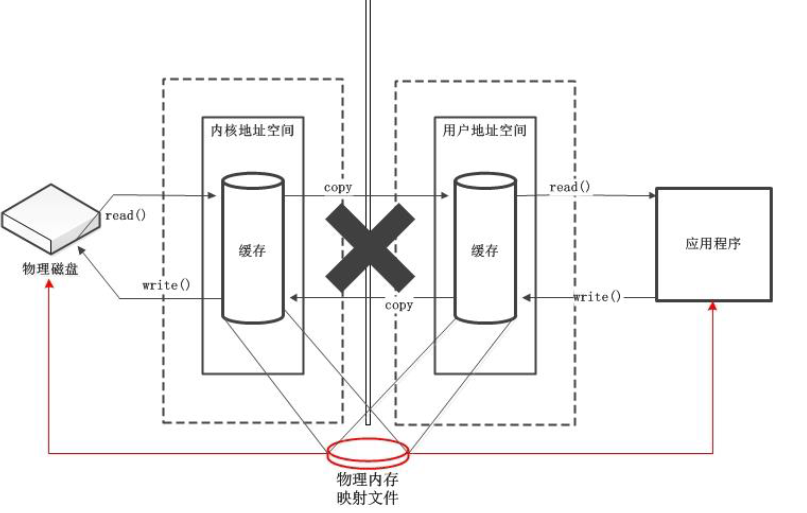
直接缓冲区通过在操作系统和JVM之间创建物理内存映射文件加快缓冲区数据读/写入物理磁盘的速度。放到物理内存映射文件中的数据就不归应用程序控制了,操作系统会自动将物理内存映射文件中的数据写入到物理内存中
五、通道(Channel)
1、简介
Channel由java.nio.channels 包定义的。Channel 表示IO 源与目标打开的连接。Channel 类似于传统的“流”。只不过Channel 本身不能直接访问数据,Channel 只能与Buffer 进行交互
2、图解
应用程序进行读写操作调用函数时,底层调用的操作系统提供给用户的读写API,调用这些API时会生成对应的指令,CPU则会执行这些指令。在计算机刚出现的那段时间,所有读写请求的指令都有CPU去执行,过多的读写请求会导致CPU无法去执行其他命令,从而CPU的利用率降低

后来,DMA(Direct Memory Access,直接存储器访问)出现了。当IO请求传到计算机底层时,DMA会向CPU请求,让DMA去处理这些IO操作,从而可以让CPU去执行其他指令。DMA处理IO操作时,会请求获取总线的使用权。当IO请求过多时,会导致大量总线用于处理IO请求,从而降低效率
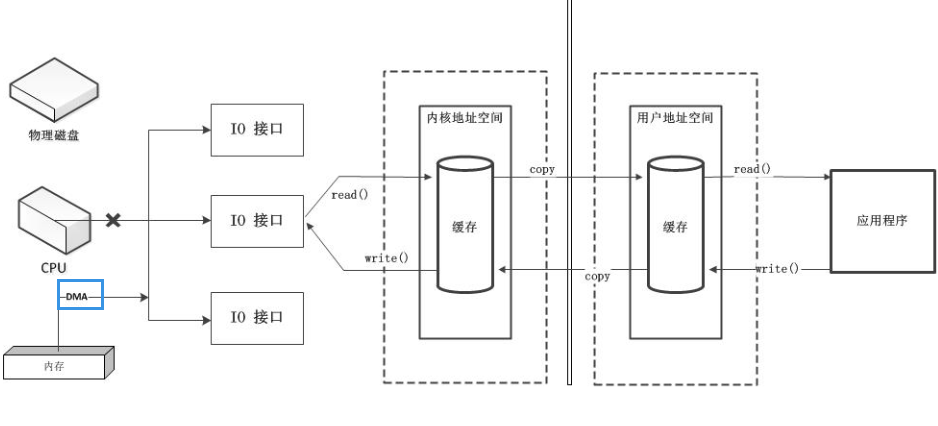
于是便有了Channel(通道),Channel相当于一个专门用于IO操作的独立处理器,它具有独立处理IO请求的能力,当有IO请求时,它会自行处理这些IO请求
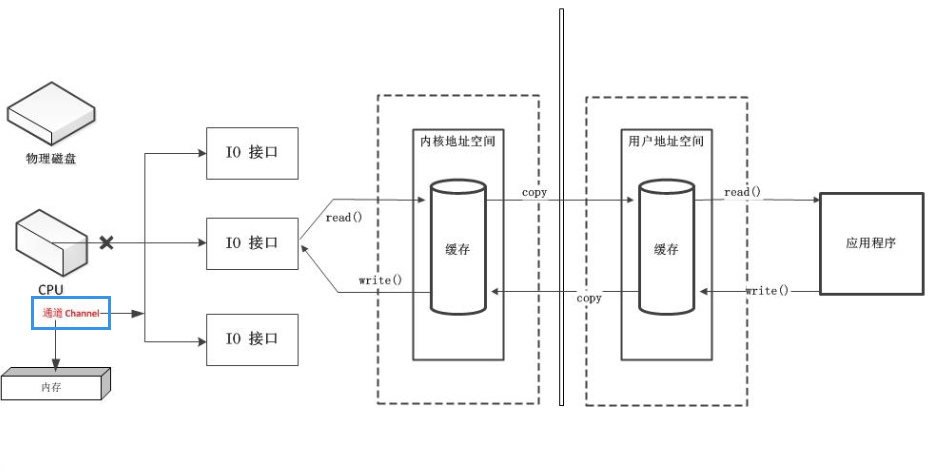
3、Java Channel
常用实现类

- 本地文件IO
- FileChannel
- 网络IO
- SocketChanel、ServerSocketChannel:用于TCP传输
- DatagramChannel:用于UDP传输
获得通道的方法
获取通道的一种方式是对支持通道的对象调用getChannel() 方法。支持通道的类如下:
- FileInputStream
- FileOutputStream
- RandomAccessFile
- DatagramSocket
- Socket
- ServerSocket
public class Demo2 {
public static void main(String[] args) throws IOException {
// 本地通道
FileInputStream fileInputStream = new FileInputStream("");
FileChannel channel1 = fileInputStream.getChannel();
FileOutputStream fileOutputStream = new FileOutputStream("");
FileChannel channel2 = fileOutputStream.getChannel();
// 网络通道
Socket socket = new Socket();
SocketChannel channel3 = socket.getChannel();
ServerSocket serverSocket = new ServerSocket();
ServerSocketChannel channel4 = serverSocket.getChannel();
DatagramSocket datagramSocket = new DatagramSocket();
DatagramChannel channel5 = datagramSocket.getChannel();
// 最后要关闭通道
}
}也可以通过通道的静态方法open()来获取
public static void main(String[] args) throws IOException {
FileChannel open = FileChannel.open(Paths.get(""));
SocketChannel open1 = SocketChannel.open();
...
}getChannel()+非直接缓冲区
- getChannel()获得通道
- allocate()获得非直接缓冲区
通过非直接缓冲区读写数据,需要通过通道来传输缓冲区里的数据
public class Demo4 {
public static void main(String[] args) {
FileInputStream is = null;
FileOutputStream os = null;
// 获得通道
FileChannel inChannel = null;
FileChannel outChannel = null;
// 利用 try-catch-finally 保证关闭
try {
is = new FileInputStream("F:\\JDKLearning\\src\\main\\NIO\\day1\\1.jpg");
os = new FileOutputStream("F:\\JDKLearning\\src\\main\\NIO\\day1\\2.jpg");
// 获得通道
inChannel = is.getChannel();
outChannel = os.getChannel();
// 获得缓冲区,用于在通道中传输数据
ByteBuffer byteBuffer = ByteBuffer.allocate(1024);
// 循环将字节数据放入到buffer中,然后写入磁盘中
while (inChannel.read(byteBuffer) != -1) {
// 切换模式
byteBuffer.flip();
outChannel.write(byteBuffer);
byteBuffer.clear();
}
} catch (IOException e) {
e.printStackTrace();
} finally {
if (inChannel != null) {
try {
inChannel.close();
} catch (IOException e) {
e.printStackTrace();
}
}
if (outChannel != null) {
try {
outChannel.close();
} catch (IOException e) {
e.printStackTrace();
}
}
if (is != null) {
try {
is.close();
} catch (IOException e) {
e.printStackTrace();
}
}
if (os != null) {
try {
os.close();
} catch (IOException e) {
e.printStackTrace();
}
}
}
}
}图片读取后,被写入到了指定位置
open()+直接缓冲区
- 通过open获得通道
- 通过FileChannel.map()获取直接缓冲区
使用直接缓冲区时,无需通过通道来传输数据,直接将数据放在缓冲区内即可
public class Demo5 {
public static void main(String[] args) throws IOException {
// 通过open()方法来获得通道
FileChannel inChannel = FileChannel.open(Paths.get("F:\\JDKLearning\\src\\main\\NIO\\day1\\1.jpg"), StandardOpenOption.READ);
// outChannel需要为 READ WRITE CREATE模式
// READ WRITE是因为后面获取直接缓冲区时模式为READ_WRITE模式
// CREATE是因为要创建新的文件
FileChannel outChannel = FileChannel.open(Paths.get("F:\\JDKLearning\\src\\main\\NIO\\day1\\3.jpg"), StandardOpenOption.READ, StandardOpenOption.WRITE, StandardOpenOption.CREATE);
// 获得直接缓冲区
MappedByteBuffer inMapBuf = inChannel.map(FileChannel.MapMode.READ_ONLY, 0, inChannel.size());
MappedByteBuffer outMapBuf = outChannel.map(FileChannel.MapMode.READ_WRITE, 0, inChannel.size());
// 字节数组
byte[] bytes = new byte[inMapBuf.limit()];
// 因为是直接缓冲区,可以直接将数据放入到内存映射文件,无需通过通道传输
inMapBuf.get(bytes);
outMapBuf.put(bytes);
// 关闭缓冲区,这里没有用try-catch-finally
inChannel.close();
outChannel.close();
}
}运行结果,图片被创建
通道间直接传输
public static void channelToChannel() throws IOException {
long start = System.currentTimeMillis();
// 通过open()方法来获得通道
FileChannel inChannel = FileChannel.open(Paths.get("F:\\JDKLearning\\src\\main\\NIO\\day1\\1.mp4"), StandardOpenOption.READ);
// outChannel需要为 READ WRITE CREATE模式
// READ WRITE是因为后面获取直接缓冲区时模式为READ_WRITE模式
// CREATE是因为要创建新的文件
FileChannel outChannel = FileChannel.open(Paths.get("F:\\JDKLearning\\src\\main\\NIO\\day1\\4.mp4"), StandardOpenOption.READ, StandardOpenOption.WRITE, StandardOpenOption.CREATE);
// 通道间直接传输
inChannel.transferTo(0, inChannel.size(), outChannel);
// 对应的还有transferFrom
// outChannel.transferFrom(inChannel, 0, inChannel.size());
inChannel.close();
outChannel.close();
}直接缓冲区VS非直接缓冲区
效率
读取一个MP4文件,通过二者花费时间的多少来判定执行的速度
// getChannel() + 非直接缓冲区耗时
708
// open() + 直接缓冲区耗时
115
// channel transferTo channel耗时
47内存占用
直接缓冲区的读写速度虽然很快,但是会占用很多很多内存空间。如果文件过大,会使得计算机运行速度变慢
4、分散和聚集
分散读取
分散读取(Scattering Reads)是指从Channel 中读取的数据“分散”到多个Buffer 中
注意:按照缓冲区的顺序,从Channel 中读取的数据依次将 Buffer 填满

聚集写入
聚集写入(Gathering Writes)是指将多个Buffer 中的数据“聚集”到Channel
按照缓冲区的顺序,写入position 和limit 之间的数据到Channel
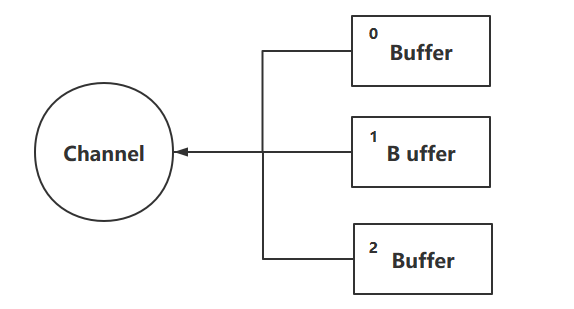
代码
public class Demo2 {
public static void main(String[] args) throws IOException {
FileInputStream is = new FileInputStream("F:\\JDKLearning\\src\\main\\nio\\day2\\计划.txt");
FileOutputStream os = new FileOutputStream("F:\\JDKLearning\\src\\main\\nio\\day2\\计划2.txt");
FileChannel inChannel = is.getChannel();
FileChannel outChannel = os.getChannel();
// 获得多个缓冲区,并且放入到缓冲区数组中
ByteBuffer byteBuffer1 = ByteBuffer.allocate(50);
ByteBuffer byteBuffer2 = ByteBuffer.allocate(1024);
ByteBuffer[] byteBuffers = {byteBuffer1, byteBuffer2};
// 分散读取
inChannel.read(byteBuffers);
byteBuffer1.flip();
byteBuffer2.flip();
// 聚集写入
outChannel.write(byteBuffers);
}
}

六、非阻塞式网络通信
1、概念
举例
双11买的快递到了,快递小哥给你打电话说马上到小区门口,麻烦在门口等一下,方便签收快递
若为阻塞式的,你到了小区门口以后,快递小哥还没到的期间,你什么事儿也做不了
若为非阻塞式的,快递小哥将快递放到门卫处,门卫给你发消息说快递到了,麻烦去取一下。当快递还没到的时候你可以做你自己的事儿
阻塞式网络通信
传统的IO 流都是阻塞式的。也就是说,当一个线程调用read() 或write() 时,该线程被阻塞,直到有一些数据被读取或写入,该线程在此期间不能执行其他任务
因此,在完成网络通信进行IO 操作时,由于线程会阻塞,所以服务器端必须为每个客户端都提供一个独立的线程进行处理,当服务器端需要处理大量客户端时,性能急剧下降
也就是说,服务器在等待IO准备就绪的期间,线程处于阻塞状态,若为单线程,等待期间CPU未执行任何任务,效率降低。所以需要开启多个线程,当某些线程因为等待IO准备就绪时,CPU可以去执行其他线程中的任务。但是线程的创建、切换与销毁的开销也是不小的。当大量的任务到来时,服务器性能也急剧下降。
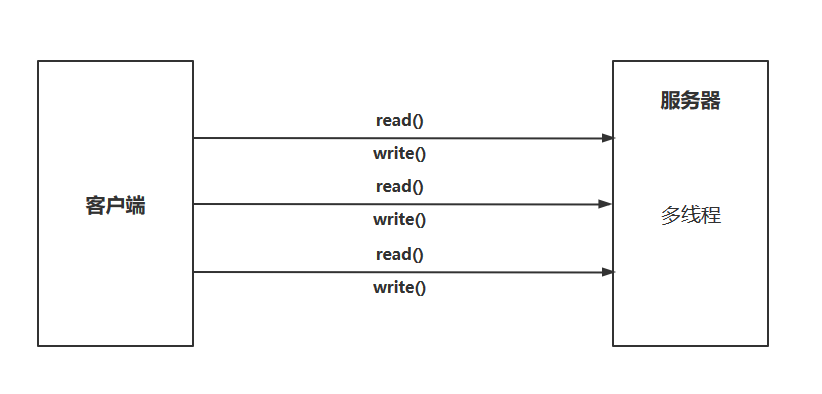
非阻塞式网络通信
Java NIO 是非阻塞模式的。当线程从某通道进行读写数据时,若没有数据可用时,该线程可以进行其他任务。线程通常将非阻塞IO 的空闲时间用于在其他通道上执行IO 操作,所以单独的线程可以管理多个输入和输出通道
因此,NIO 可以让服务器端使用一个或有限几个线程来同时处理连接到服务器端的所有客户端

2、使用
阻塞式网络通信演示
public class Demo1 {
public static void main(String[] args) throws IOException {
Thread thread1 = new Thread(()->{
try {
server();
} catch (IOException e) {
e.printStackTrace();
}
});
Thread thread2 = new Thread(()->{
try {
client();
} catch (IOException e) {
e.printStackTrace();
}
});
thread1.start();
thread2.start();
}
public static void client() throws IOException {
// 创建客户端通道
SocketChannel socketChannel = SocketChannel.open(new InetSocketAddress("127.0.0.1", 2022));
// 读取信息
FileChannel fileChannel = FileChannel.open(Paths.get("F:\\JDKLearning\\src\\main\\nio\\day3\\1.jpg"), StandardOpenOption.READ);
// 创建缓冲区
ByteBuffer byteBuffer = ByteBuffer.allocate(1024);
// 写入数据
while (fileChannel.read(byteBuffer) != -1) {
byteBuffer.flip();
socketChannel.write(byteBuffer);
byteBuffer.clear();
}
fileChannel.close();
socketChannel.close();
}
public static void server() throws IOException {
// 创建服务端通道
ServerSocketChannel serverSocketChannel = ServerSocketChannel.open();
FileChannel fileChannel = FileChannel.open(Paths.get("F:\\JDKLearning\\src\\main\\nio\\day3\\2.jpg"), StandardOpenOption.WRITE, StandardOpenOption.CREATE);
// 绑定链接
serverSocketChannel.bind(new InetSocketAddress(2022));
// 获取客户端的通道
SocketChannel socketChannel = serverSocketChannel.accept();
// 创建缓冲区
ByteBuffer byteBuffer = ByteBuffer.allocate(1024);
while (socketChannel.read(byteBuffer) != -1) {
byteBuffer.flip();
fileChannel.write(byteBuffer);
byteBuffer.clear();
}
socketChannel.close();
fileChannel.close();
serverSocketChannel.close();
}
}非阻塞式网络通信演示
public class DemoNIO {
public static void main(String[] args) {
Thread thread1 = new Thread(()->{
try {
server();
} catch (IOException e) {
e.printStackTrace();
}
});
Thread thread2 = new Thread(()->{
try {
client();
} catch (IOException e) {
e.printStackTrace();
}
});
thread1.start();
thread2.start();
}
public static void client() throws IOException {
SocketChannel socketChannel = SocketChannel.open(new InetSocketAddress("127.0.0.1", 2020));
// 设置为非阻塞模式
socketChannel.configureBlocking(false);
ByteBuffer byteBuffer = ByteBuffer.allocate(1024);
Scanner scanner = new Scanner(System.in);
while (scanner.hasNext()) {
String str = scanner.next();
byteBuffer.put(str.getBytes());
byteBuffer.flip();
socketChannel.write(byteBuffer);
byteBuffer.clear();
}
byteBuffer.clear();
socketChannel.close();
}
public static void server() throws IOException {
ServerSocketChannel serverSocketChannel = ServerSocketChannel.open();
serverSocketChannel.configureBlocking(false);
serverSocketChannel.bind(new InetSocketAddress(2020));
// 获得选择器
Selector selector = Selector.open();
// 将通道注册到选择器中,设定为接收操作
serverSocketChannel.register(selector, SelectionKey.OP_ACCEPT);
// 轮训接受
while (selector.select() > 0) {
Iterator<SelectionKey> iterator = selector.selectedKeys().iterator();
// 获得事件的key
while (iterator.hasNext()) {
SelectionKey key = iterator.next();
if (key.isAcceptable()) {
SocketChannel socketChannel = serverSocketChannel.accept();
socketChannel.configureBlocking(false);
socketChannel.register(selector, SelectionKey.OP_READ);
} else if (key.isReadable()) {
// 从选择器中获取通道
SocketChannel socketChannel = (SocketChannel) key.channel();
ByteBuffer byteBuffer = ByteBuffer.allocate(10);
while (socketChannel.read(byteBuffer) != -1) {
int len = byteBuffer.limit();
byteBuffer.flip();
System.out.println(new String(byteBuffer.array(), 0, len));
byteBuffer.clear();
}
socketChannel.close();
}
iterator.remove();
}
}
serverSocketChannel.close();
}
}选择器
选择器(Selector)是SelectableChannle 对象的多路复用器,Selector 可以同时监控多个SelectableChannel 的IO 状况,也就是说,利用Selector 可使一个单独的线程管理多个Channel。Selector 是非阻塞IO 的核心
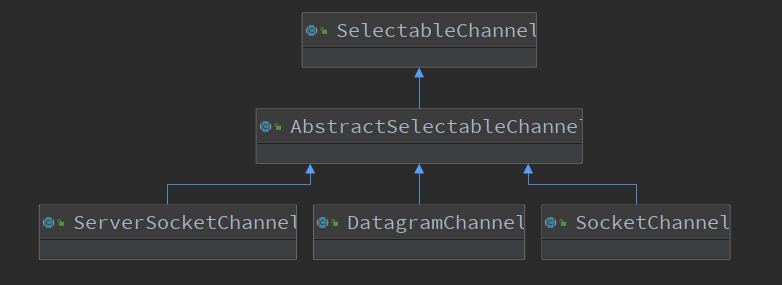
选择器的创建
// 创建一个选择器
Selector selector = Selector.open();绑定选择器
通过调用通道的register方法可以绑定选择器,register方法有两个参数
Selector:即绑定哪个选择器
ops:监听事件类型。ops有4个值可以选择,为SelectionKey的静态属性

// 让选择器监听一种状态
myChannel.register(selector, SelectionKey.OP_READ);
// 让选择器监听多种状态
myChannel.register(selector, SelectionKey.OP_READ | SelectionKey.OP_ACCEPT);SelectionKey
表示SelectableChannel 和Selector 之间的注册关系。每次向选择器注册通道时就会选择一个事件(选择键)。选择键包含两个表示为整数值的操作集。操作集的每一位都表示该键的通道所支持的一类可选择操作g
本博客所有文章除特别声明外,均采用 CC BY-SA 4.0 协议 ,转载请注明出处!